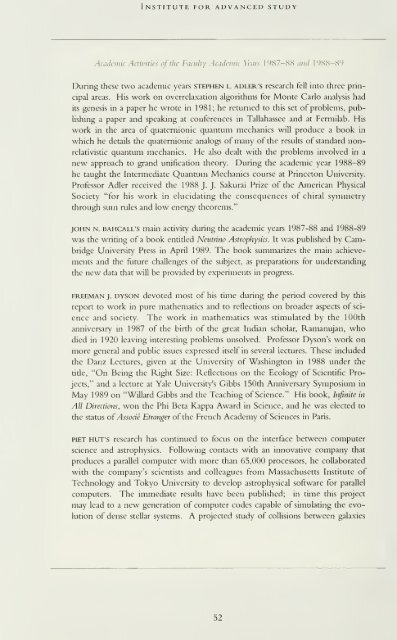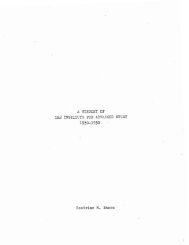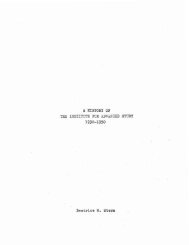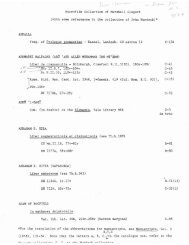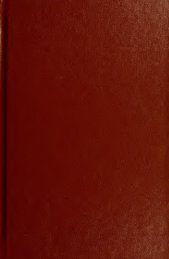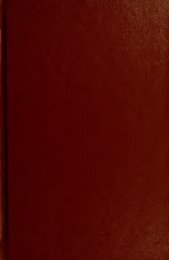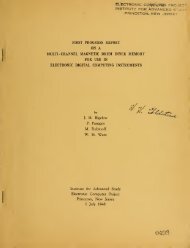Report for the Academic Years 1987-1988 and 1988-1989
Report for the Academic Years 1987-1988 and 1988-1989
Report for the Academic Years 1987-1988 and 1988-1989
Create successful ePaper yourself
Turn your PDF publications into a flip-book with our unique Google optimized e-Paper software.
Institute <strong>for</strong> advanced study<br />
<strong>Academic</strong> Activities of <strong>the</strong> Faculty <strong>Academic</strong> <strong>Years</strong> <strong>1987</strong>-88 <strong>and</strong> <strong>1988</strong>-89<br />
During <strong>the</strong>se two academic years Stephen l. adler's research fell into three prin-<br />
cipal areas. His work on overrelaxation algorithms <strong>for</strong> Monte Carlo analysis had<br />
its genesis in a paper he wrote in 1981; he returned to this set of problems, pub-<br />
hshing a paper <strong>and</strong> speaking at conferences in Tallahassee <strong>and</strong> at Fermilab. His<br />
work in <strong>the</strong> area of quatemionic quantum mechanics will produce a book in<br />
which he details <strong>the</strong> quatemionic analogs of many of <strong>the</strong> results of st<strong>and</strong>ard non-<br />
relativistic quantum mechanics. He also dealt with <strong>the</strong> problems involved in a<br />
new approach to gr<strong>and</strong> unification <strong>the</strong>ory. During <strong>the</strong> academic year <strong>1988</strong>-89<br />
he taught <strong>the</strong> Intermediate Quantum Mechanics course at Princeton University.<br />
Professor Adler received <strong>the</strong> <strong>1988</strong> J. J. Sakurai Prize of <strong>the</strong> American Physical<br />
Society "<strong>for</strong> his work in elucidating <strong>the</strong> consequences of chiral symmetry<br />
through sum rules <strong>and</strong> low energy <strong>the</strong>orems."<br />
JOHN n. bahcall's main activity dunng <strong>the</strong> academic years <strong>1987</strong>-88 <strong>and</strong> <strong>1988</strong>-89<br />
was <strong>the</strong> writing of a book entided Neutrino Astrophysics. It was published by Cam-<br />
bridge University Press in April <strong>1989</strong>. The book summarizes <strong>the</strong> main achieve-<br />
ments <strong>and</strong> <strong>the</strong> fijture challenges of <strong>the</strong> subject, as preparations <strong>for</strong> underst<strong>and</strong>ing<br />
<strong>the</strong> new data that will be provided by experiments in progress.<br />
freeman J. DYSON devoted most of his time during <strong>the</strong> period covered by this<br />
report to work in pure ma<strong>the</strong>matics <strong>and</strong> to reflecrions on broader aspects of sci-<br />
ence <strong>and</strong> society. The work in ma<strong>the</strong>matics was stimulated by <strong>the</strong> 100th<br />
anniversary in <strong>1987</strong> of <strong>the</strong> birth of <strong>the</strong> great Indian scholar, Ramanujan, who<br />
died in 1920 leaving interesting problems unsolved. Professor Dyson's work on<br />
more general <strong>and</strong> public issues expressed itself in several lectures. These included<br />
<strong>the</strong> Danz Lectures, given at <strong>the</strong> University of Washington in 1 988 under <strong>the</strong><br />
tide, "On Being <strong>the</strong> Right Size: Reflecrions on <strong>the</strong> Ecology of Scientific Pro-<br />
jects," <strong>and</strong> a lecture at Yale University's Gibbs 150th Anniversary Symposium in<br />
May <strong>1989</strong> on "Willard Gibbs <strong>and</strong> <strong>the</strong> Teaching of Science." His book, Infmite in<br />
All Directions, won <strong>the</strong> Phi Beta Kappa Award in Science, <strong>and</strong> he was elected to<br />
<strong>the</strong> status of Associe Etranger of <strong>the</strong> French Academy of Sciences in Paris.<br />
PIET HUT'S research has continued to focus on <strong>the</strong> interface between computer<br />
science <strong>and</strong> astrophysics. Following contacts with an innovative company that<br />
produces a parallel computer with more than 65,000 processors, he collaborated<br />
with <strong>the</strong> company's scientists <strong>and</strong> colleagues from Massachusetts Institute of<br />
Technology <strong>and</strong> Tokyo University to develop astrophysical software <strong>for</strong> parallel<br />
computers. The immediate results have been published; in time this project<br />
may lead to a new generation of computer codes capable of simulating <strong>the</strong> evo-<br />
lution of dense stellar systems. A projected study of collisions between galaxies<br />
52


